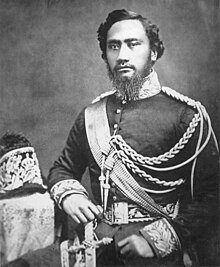Kamehameha IV
| Kamehameha IV | |||||
|---|---|---|---|---|---|
 |
|||||
| King of the Hawaiian Islands (more...) | |||||
| Reign | January 11, 1855 – November 30, 1863 | ||||
| Investiture | January 11, 1855 Kawaiahaʻo Church |
||||
| Predecessor | Kamehameha III | ||||
| Successor | Kamehameha V | ||||
| Kuhina Nui |
Keoni Ana Kaʻahumanu IV |
||||
| Born |
February 9, 1834 Honolulu, Oʻahu |
||||
| Died | November 30, 1863 (aged 29) Honolulu, Oʻahu |
||||
| Burial | February 3, 1864 Mauna ʻAla Royal Mausoleum |
||||
| Spouse | Queen Emma | ||||
| Issue | Albert Edward Kauikeaouli | ||||
|
|||||
| House | House of Kamehameha | ||||
| Father |
Kekūanāoʻa Kamehameha III (hānai) |
||||
| Mother |
Kīnaʻu Kalama (hānai) |
||||
| Religion | Church of Hawaii | ||||
| Signature | |||||
| Full name | |
|---|---|
| Alekanetero (Alexander) ʻIolani Kalanikualiholiho Maka o ʻIouli Kūnuiākea o Kūkāʻilimoku. |
Kamehameha IV, born Alexander ʻIolani Liholiho (1834–1863), reigned as the fourth monarch of Hawaii under the title: Ke Aliʻi o ko Hawaiʻi Pae ʻAina of the Kingdom of Hawaii from January 11, 1855 to November 30, 1863. His full Hawaiian name was Alekanetero ʻIolani Kalanikualiholiho Maka o ʻIouli Kūnuiākea o Kūkāʻilimoku.
Alexander was born on February 9, 1834 in Honolulu on the island of Oʻahu. His father was High Chief Mataio Kekūanāoʻa, Royal Governor of Oʻahu. His mother was Princess Elizabeth Kīnaʻu the Kuhina Nui or Prime Minister of the Kingdom. He was the grandson of all the islands. As a toddler, Alexander was adopted by his uncle, King Kamehameha III who decreed Alexander heir to the throne and raised him as the crown prince.
His name ʻIolani means “Hawk of heaven,” or “Royal hawk”.
Alexander Liholiho was educated by Congregationalist missionaries Amos and Juliette Cooke at the Chiefs' Children's School (later known as Royal School) in Honolulu. He was accompanied by 30 attendants (kahu) when he arrived, but they were sent home and for the first time Liholiho was on his own. Alexander Liholiho played the flute and the piano, and enjoyed singing, acting, and cricket. When he was 14 he left the Royal School and went to law school. When he was 15, he went on a government trip to England, the United States, and Panama. Liholiho was able to record the events of his trip in a journal.
A diplomatic mission was planned following Admiral de Tromelin's 1849 attack on the fort of Honolulu, the result of French claims stemming back twenty years to the expulsion of Catholic missionaries. Contention surrounded three issues: regulations of Catholic schools, high taxes on French brandy, and the use of French language in transactions with the consul and citizens of France. Although this struggle had gone on for many years, the Hawaiian king finally sent Gerrit P. Judd to try for the second time to negotiate a treaty with France. Envoys Haʻalilio and William Richards had gone on the same mission in 1842 and returned with only a weak joint declaration. It was hoped the treaty would secure the islands against future attacks such as the one it had just suffered at the hands of Admiral de Tromelin. Advisors to Kamehameha III thought it best that the heir apparent, Alexander, and his brother, Lot Kapuāiwa, would benefit from the travel.
...
Wikipedia
